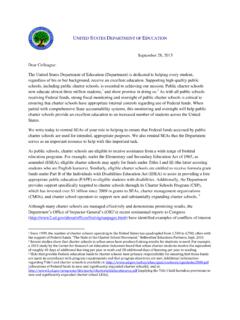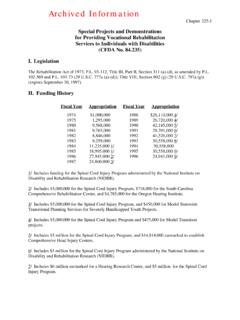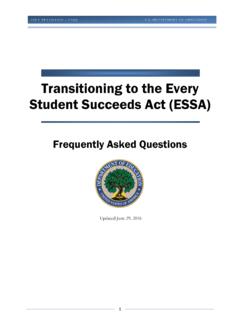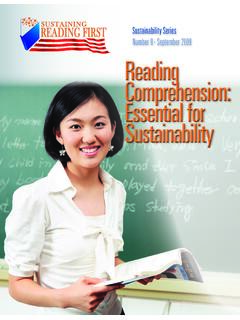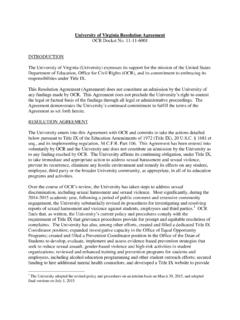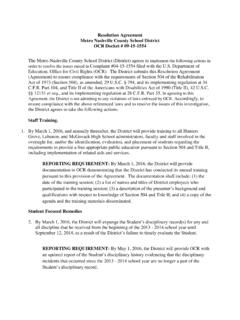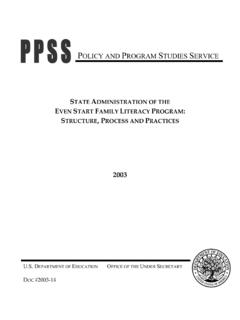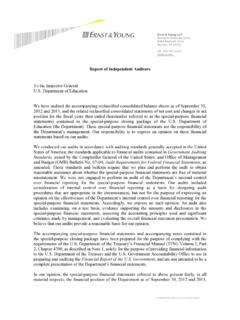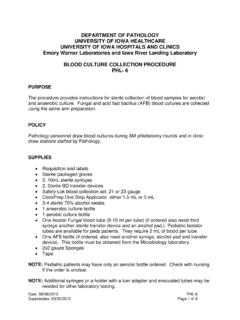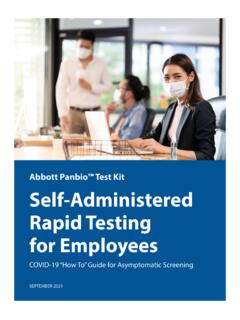Transcription of TRACKING THE PROGRESS OF ENGLISH LEARNERS - ed
1 Updated November 20161 TOOLS AND RESOURCES FOR MONITORING AND EXITING ENGLISH LEARNERS FROM EL PROGRAMS AND SERVICES ESSA UPDATE INCLUDED*CHAPTER 8 TOOLS AND RESOURCES FOR MONITORING AND EXITING ENGLISH LEARNERS FROM EL PROGRAMS AND SERVICESThis is the eighth chapter of the ENGLISH Learner Tool Kit, which is intended to help state and local education agencies (SEAs and LEAs) in meeting their obligations to ENGLISH LEARNERS (ELs). This tool kit should be read in conjunction with the Department of Education Office for Civil Rights and the Department of Justice s Dear Colleague Letter on ENGLISH Learner Students and Limited ENGLISH Proficient Parents, published in January 2015, which outlines SEAs and LEAs legal obligations to ELs under civil rights laws and other federal requirements.
2 The Dear Colleague Letter can be found at THE PROGRESS OF ENGLISH LEARNERSKEY POINTS LEAs must monitor the PROGRESS of all ELs in achieving ENGLISH language proficiency (ELP) and in acquiring content knowledge. LEAs should establish rigorous monitoring systems that include benchmarks for expected growth and take appropriate steps to assist students who are not adequately progressing towards those goals. SEAs must monitor LEAs to ensure that they are providing ELs meaningful access to grade level core content instruction and remedying any academic deficits in a timely must monitor and regularly assess the PROGRESS of all ELs, including those who have opted out of EL programs, in both ENGLISH language proficiency (ELP) and content knowledge.
3 This includes conducting an annual ELP assessment and, at least annually, measuring their performance in grade-level core content rigorous monitoring systems that include periodic benchmarks allows LEAs to monitor ELs PROGRESS over time, determine when students are not making appropriate PROGRESS , and provide additional support to enable ELs to reach ENGLISH proficiency and gain grade-level content knowledge. SEAs must monitor LEAs to ensure that they are providing ELs meaningful access to grade-level core content instruction and remedying any academic deficits in a timely manner. ELs could benefit from multi-tiered systems of support.
4 One such system for supporting students, including ELs, is Response to Intervention (RTI). RTI is not an EL program and may not substitute for one. However, RTI can provide additional systems of support for ELs in areas such as assessment, screening, intervention, and monitoring, which when combined can help improve instructional outcomes for ELs (Brown & Sanford, 2011; S enz, 2008). Educators, including teachers, need tools that help them continually monitor students PROGRESS and adjust instructional strategies to target and support students needs. Regularly monitoring ELs PROGRESS in ELP and content knowledge allows teachers to target instruction and provide additional support services, as needed.
5 For ELP, LEAs must assess ELs at least annually using a valid *This chapter has been updated to reflect changes in the Elementary and Secondary Education Act (ESEA), as amended by the Every Student Succeeds Act of 2015 (ESSA). The Department of Education has released a non-regulatory guidance (NRG) about ESSA and ELs that is available at The text of the ESEA, as amended by ESSA, can be found at November 2016 You can access Tools and Resources for Monitoring and Exiting ENGLISH LEARNERS from EL Programs and Servicesat can access Tools and Resources for Monitoring and Exiting ENGLISH LEARNERS from EL Programs and Servicesat AND RESOURCES FOR MONITORING AND EXITING ENGLISH LEARNERS FROM EL PROGRAMS AND SERVICES Updated November 2016and reliable assessment that is aligned to state ELP standards.
6 In addition, periodic formative assessments of ELP help inform instruction and support ELs ENGLISH language development throughout the school year. EL PROGRESS should inform EL program evaluations. See Chapter 9 of this tool kit for information on evaluating the effectiveness of an LEA s EL ENGLISH LEARNERS KEY POINTS LEAs must document that an EL has demonstrated ENGLISH proficiency using a valid and reliable ELP assessment that tests all four language domains. Students exiting from EL status must be monitored for at least two years, to ensure that (1) they have not been prematurely exited; (2) any academic deficits incurred as a result of participating in the EL program have been remedied; and (3) they are meaningfully participating in the standard program of instruction comparable to their never EL peers.
7 In addition, the ESEA now requires LEAs to report on the number and percentage of former ELs meeting state academic standards for four must use valid and reliable ELP assessments that test all four language domains (listening, speaking, reading, and writing) to ensure that ELs have achieved ENGLISH proficiency. The proficiency score on the ELP assessment must be set at a level that enables students to effectively participate in grade-level content instruction in ENGLISH without EL services. This does not mean that students must score proficient on a content assessment ( , reading/language arts) in order to exit EL status; indeed, there are never-EL students who are in the general education program who do not score proficient on these content may use additional objective criteria related to ENGLISH proficiency to decide if an EL who scores proficient on the ELP assessment is ready to exit EL services.
8 However, these additional criteria may not substitute for a proficient score on a valid and reliable ELP assessment. Exiting EL students either too soon or too late raises civil rights concerns. EL students who are exited too soon are denied access to EL services while EL students who are exited too late may be denied access to parts of the general curriculum. Denied or delayed access to the general curriculum can impede academic growth and contribute to a higher risk of dropping out of students have exited an EL program, LEAs must monitor their academic PROGRESS for at least two years. If an exited EL is not progressing academically as expected and monitoring suggests a persistent language need, LEAs should re-test the student s ELP with a valid, reliable, and grade-appropriate ELP test to see if the student must be offered additional language assistance services.
9 In no case should re-testing of an exited student s ELP be prohibited. If the student is reentered into EL services, however, the LEA should document the reasons why and the parent s consent to reentry. If SEAs or LEAs find that changes to exit criteria or procedures are necessary, SEAs and LEAs need to provide teachers and staff with appropriate training. ESSA UPDATEU nder Title III of the ESEA, as amended by ESSA [Section 3121(a)(5)], LEAs must report on the number and percentage of former ELs meeting state standards for four years. For more information, see section J of the NRG ( Department of Education, Office of Elementary and Secondary Education, 2016).
10 In addition, the ESEA [Section 3113(b)(2)] requires standardized statewide entrance and exit procedures for following checklist is intended to assist with TRACKING the PROGRESS of ELs and exiting ELs. The checklist provides suggested questions only. Schools and LEAs should check their SEA s policies and federal guidance to ensure the PROGRESS of ELs Are all ELs, including those who have opted out of EL programs and services, monitored at least annually for PROGRESS in achieving ELP and acquiring content knowledge? You can access Tools and Resources for Monitoring and Exiting ENGLISH LEARNERS from EL Programs and Servicesat AND RESOURCES FOR MONITORING AND EXITING ENGLISH LEARNERS FROM EL PROGRAMS AND SERVICES Updated November 2016 Are LEAs monitoring ELs PROGRESS toward established benchmarks for expected growth in ELP and the grade-level content areas and assisting students who are not making timely PROGRESS towards those goals?
